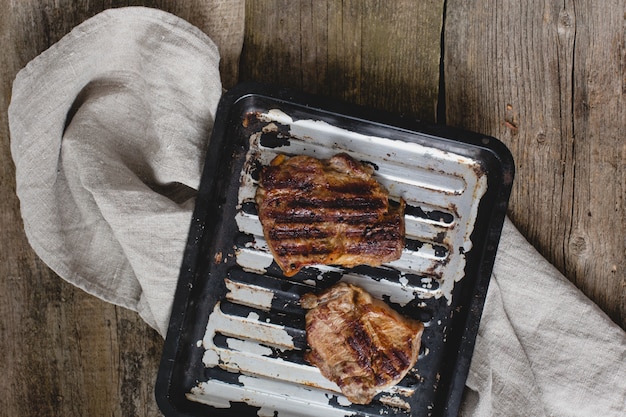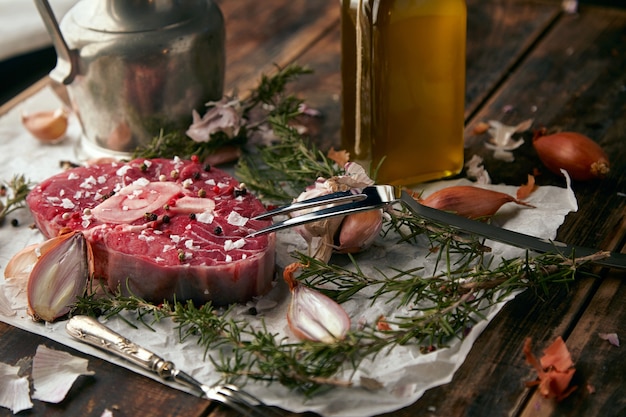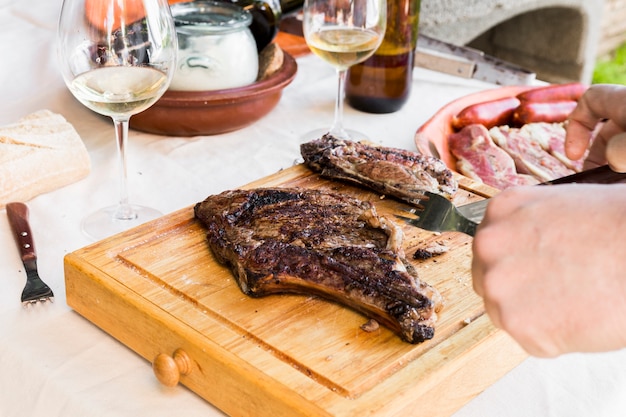Let's talk about beef sirloin tip roasts. You know, the kind that conjures up images of hearty meals shared with loved ones, the aroma of sizzling meat filling the kitchen, and that satisfying crunch of a perfectly browned crust. But before you dive into the cooking process, let's take a moment to demystify the art of preparing a sirloin tip roast. This isn't just a recipe, it's an adventure – a journey into the heart of flavour, where we'll unravel the secrets to a juicy, tender roast that'll have everyone begging for seconds.
(Part 1) Picking the Perfect Piece: Selecting Your Sirloin Tip Roast

It all starts with the right piece of meat. You see, a good sirloin tip roast is like a well-crafted symphony – each note, each ingredient, plays its part to create a harmonious culinary experience. And like choosing the right instrument for a symphony, selecting the perfect sirloin tip roast requires a keen eye and a touch of culinary intuition.
Size Matters
The first thing to consider is size. You want a roast that's big enough to satisfy everyone at the table without becoming a culinary battleground. A 3-4 pound roast is typically a good size, offering a generous portion without being overwhelming. Imagine a roast that effortlessly feeds a family of four, leaving everyone with a contented smile and a full belly.
The Fat Factor: Don't Be Afraid of Fat
Now, don't be afraid of fat! Fat is the secret ingredient to a juicy, flavorful roast. Look for a roast with a good layer of fat, ideally marbled throughout the meat. That layer of fat will melt during cooking, basting the meat and ensuring every bite is tender and succulent.
Marbling: The Key to Tenderness
Speaking of fat, marbling plays a crucial role in the tenderness and flavour of your roast. Marbling is the fat that runs through the muscle, creating little veins of flavour. The more marbling you see, the richer and juicier your roast will be. Think of it as tiny pockets of deliciousness throughout the meat.
Shape and Texture: The Final Check
Finally, take a moment to feel the roast. It should feel firm, not too squishy, indicating it's been handled with care. A slight springiness is a good sign.
(Part 2) Setting the Stage: Preparing Your Roast

Now that you've got your star ingredient, it's time to get ready for the show.
Room Temperature: Letting the Meat Relax
First, bring the roast to room temperature. Don't rush the process! Take it out of the fridge an hour or two before cooking, allowing it to relax and come to room temperature. This ensures it cooks more evenly. Imagine your roast like a shy performer, given time to warm up before taking center stage.
Pat It Dry: A Little TLC
Next, pat the roast dry with paper towels. This removes excess moisture, allowing for a beautiful, crispy crust to form during cooking. Think of it as a little TLC to help your roast shine.
Seasoning: A Symphony of Flavors
Now comes the exciting part – seasoning! This is where you can unleash your creativity. A simple salt and pepper rub is always a classic. However, if you're feeling adventurous, try a blend of garlic powder, onion powder, paprika, and oregano. You can even add a touch of brown sugar for a hint of sweetness that caramelizes in the oven.
Tying the Roast: Keeping It in Shape
To prevent the roast from shrinking and ensure an even cook, tie it up with kitchen twine. Tie it snugly, but not too tightly. Think of it as giving your roast a little hug, holding it in shape as it transforms into culinary perfection.
(Part 3) The Grand Performance: Cooking the Roast

Here's where the real magic happens. It's a dance of heat, patience, and precision.
Preheating the Oven: Setting the Stage
Preheat your oven to 325°F (160°C). This gives your oven a chance to reach the perfect temperature, ensuring a consistent and even cook. Imagine it as preparing the stage for the grand performance.
Searing the Roast: Adding Depth of Flavor
Before the roast goes into the oven, it's time for a dramatic entrance! Sear it in a hot skillet, creating a delicious, crispy crust that locks in the juices.
Searing Technique: A Masterclass in Browning
Get your skillet nice and hot, add a tablespoon of oil, and let it shimmer. Then, add the roast and sear it on all sides, about 3-4 minutes per side. The result? A beautiful, caramelized crust that adds a symphony of flavours to your roast.
The Oven: The Grand Finale
Now, it's time to send your roast to the main stage. Place it in your preheated oven and let it cook. cooking time will depend on the size of the roast, but as a general rule, aim for 15-20 minutes per pound. For a 3-pound roast, you're looking at about 45-60 minutes.
(Part 4) Monitoring the Performance: Checking for Doneness
No performer wants to be overcooked, and your roast is no exception.
The meat thermometer: Your Culinary Guide
To ensure your roast reaches the perfect level of doneness, use a meat thermometer. For medium-rare, aim for an internal temperature of 130-135°F (54-57°C). For medium, aim for 140-145°F (60-63°C).
Resting Time: Allowing the Juices to Redistribute
Once the roast is cooked to your liking, take it out of the oven and let it rest for 10-15 minutes before carving. This allows the juices to redistribute throughout the meat, ensuring every slice is bursting with flavour. Think of it as giving your roast a moment to catch its breath and settle down.
(Part 5) Adding the Finishing Touches: Elevate Your Roast
Now, let's add some extra flavour and create a culinary masterpiece.
Sauce, Sauce, Sauce: The Secret Ingredient
Sauce is the magic ingredient that elevates a roast from good to extraordinary. There are endless possibilities, but here are a few of my favourites:
- Red Wine Sauce: A timeless classic, red wine sauce brings a rich, luxurious flavour to your roast. Simply simmer red wine, beef broth, and herbs in a saucepan until it reduces and thickens, creating a velvety, flavourful sauce.
- Mushroom Sauce: For a rich and earthy sauce, saute some mushrooms with garlic and onions, then deglaze the pan with red wine or beef broth. Add some cream and let it simmer until it thickens, resulting in a creamy and decadent sauce that perfectly complements the roast.
- Horseradish Sauce: If you prefer a bit of a kick, try a horseradish sauce. It's tangy, spicy, and adds a surprising twist to the roast. Simply mix horseradish, sour cream, and a touch of lemon juice for a refreshing and zesty sauce.
The Side Show: Perfect Accompaniments
Don't forget about the side show! These accompaniments add layers of texture and flavour to your meal:
- mashed potatoes: A classic companion, mashed potatoes provide a comforting and creamy contrast to the rich flavour of the roast.
- Roasted Vegetables: For a healthy and flavorful side, roast some vegetables like carrots, potatoes, and broccoli. The roasting process brings out their natural sweetness and adds a touch of caramelization.
- green beans: A simple yet satisfying side, green beans offer a refreshing and crisp counterpoint to the richness of the roast.
- Dinner Rolls: For a hearty and comforting side, serve some dinner rolls with your roast. These fluffy rolls soak up the delicious sauce and provide a satisfying finish to your meal.
(Part 6) The Final Act: Carving the Roast
The time has come to reveal the masterpiece you've created.
Carving with Care: The Art of Slicing
Now, this might seem simple, but there's a right way to carve a roast. First, slice across the grain, perpendicular to the muscle fibers. This technique produces tender, juicy slices that are easy to chew and melt in your mouth.
The Art of Presentation: Creating a Culinary Showstopper
Now, it's time to make it look as good as it tastes! Place your carved roast on a platter and arrange your sides around it. Don't forget to drizzle some of your delicious sauce over the top, creating a visually appealing and mouthwatering presentation.
(Part 7) Going Beyond the Basics: Adding Your Personal Touch
Let's explore some ways to add your own flair to your roast.
Spice It Up: A World of Flavors
Don't be afraid to experiment with different spices and herbs. Try adding a sprinkle of chili powder, smoked paprika, or a touch of cumin for a hint of heat. Or, go for a more earthy flavour with a blend of rosemary and thyme. The possibilities are endless!
A Touch of Sweetness: Caramelized Magic
For a touch of sweetness, try adding a tablespoon of brown sugar to your rub. It caramelizes in the oven, adding a delightful depth of flavor. Imagine a sweet, caramelized glaze enveloping your roast, creating a symphony of textures and tastes.
Glaze It Up: Adding a Shine and a Boost of Flavor
After the roast has cooked for a while, take it out of the oven and brush it with a glaze. This adds a beautiful shine and extra flavour. Try a simple glaze made with honey, soy sauce, and garlic, or get creative with your own flavour combinations.
slow cooker Magic: Hands-Off Cooking at Its Finest
For a hands-off approach, try cooking your roast in a slow cooker. Just brown the roast in a skillet first to add some flavour, then transfer it to the slow cooker with your favorite spices and vegetables. Cook on low for 6-8 hours, allowing the slow cooker to work its magic, transforming the tough, lean meat into a tender, succulent masterpiece.
(Part 8) Unveiling the Secrets: FAQs
Let's address some common questions you might have about sirloin tip roasts.
1. What's the Difference Between a Sirloin Tip Roast and a sirloin roast?
A sirloin tip roast comes from the bottom round of the beef, while a sirloin roast comes from the top sirloin. The sirloin tip roast is a leaner cut of meat, but it can be just as flavorful as a sirloin roast, especially when cooked properly.
2. Can I Cook a Sirloin Tip Roast in a Slow Cooker?
Absolutely! A slow cooker is a great option for cooking a sirloin tip roast. Just be sure to brown the roast in a skillet first to add some flavour. The slow cooker will then do the rest, gently transforming the roast into a tender and flavorful dish.
3. How Do I Know If My Sirloin Tip Roast Is Done?
The best way to check if your roast is done is to use a meat thermometer. For medium-rare, aim for an internal temperature of 130-135°F (54-57°C). For medium, aim for 140-145°F (60-63°C). This ensures you've cooked the roast to the perfect level of doneness, creating a juicy and flavorful masterpiece.
4. What Should I Serve with a Sirloin Tip Roast?
The best sides for a sirloin tip roast are mashed potatoes, roasted vegetables, green beans, and dinner rolls. These classic accompaniments offer a delicious contrast in texture and flavor, complementing the richness of the roast.
5. Can I Freeze a Sirloin Tip Roast?
Yes, you can freeze a sirloin tip roast. Just wrap it tightly in plastic wrap and aluminum foil, and store it in the freezer for up to 3 months. Thaw it in the refrigerator overnight before cooking. Freezing and thawing the roast may slightly affect the texture, but it's a great way to save leftovers or prepare for future meals.
(Part 9) The Final Curtain Call: Embrace the Art of Roasting
There you have it, the ultimate guide to cooking a perfect sirloin tip roast. Don't be afraid to get creative, experiment with different spices and herbs, and find your own signature touch. And most importantly, have fun! Remember, cooking is about more than just following a recipe; it's about creating something delicious and sharing it with the people you love. So, grab your ingredients, fire up the oven, and get ready to create a roast that will be the talk of the town. Happy cooking!
| Cooking Time | Internal Temperature | Doneness |
|---|---|---|
| 130-135°F (54-57°C) | 130-135°F (54-57°C) | Medium-Rare |
| 140-145°F (60-63°C) | 140-145°F (60-63°C) | Medium |
| 150-155°F (65-68°C) | 150-155°F (65-68°C) | Medium-Well |
| 160°F (71°C) | 160°F (71°C) | Well-Done |
Everyone is watching

Prime Rib Roast Cooking Time Chart: Per Pound Guide
Cooking TipsPrime rib roast. Just the name conjures images of lavish dinners, crackling fires, and hearty laughter. It’s ...

How Long to Bake Potatoes in the Oven (Perfect Every Time)
Cooking TipsBaked potatoes are a staple in my kitchen. They're incredibly versatile, delicious, and surprisingly easy to m...

Perfect Rice Every Time: The Ultimate Guide to Cooking Rice
Cooking TipsAs a self-proclaimed foodie, I've always been a bit obsessed with rice. It's the foundation of countless cuisi...

The Ultimate Guide to Cooking Asparagus: Tips, Techniques, and Recipes
Cooking TipsAsparagus. The mere mention of this spring delicacy conjures up images of vibrant green spears, crisp and burs...

Ultimate Guide to Cooking the Perfect Thanksgiving Turkey
Cooking TipsThanksgiving. Just the word conjures up images of overflowing tables laden with delicious food, the scent of r...
